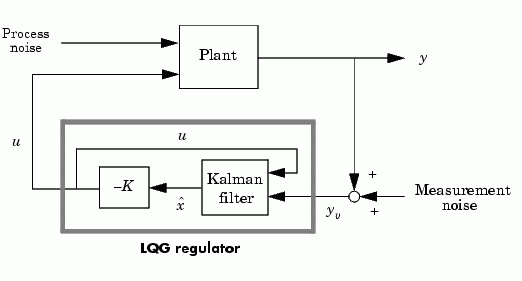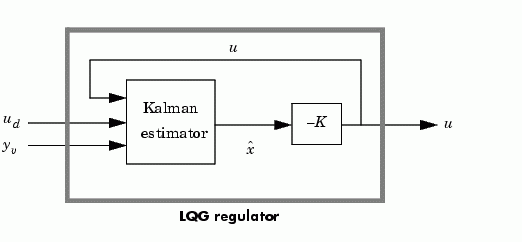

| Function Reference |   |
Form LQG regulator given state-feedback gain and Kalman estimator
Syntax
rlqg = lqgreg(kest,k) rlqg = lqgreg(kest,k,'current') % discrete-time only rlqg = lqgreg(kest,k,controls)
Description
lqgreg
forms the LQG regulator by connecting the Kalman estimator designed with kalman and the optimal state-feedback gain designed with lqr, dlqr, or lqry. The LQG regulator minimizes some quadratic cost function that trades off regulation performance and control effort. This regulator is dynamic and relies on noisy output measurements to generate the regulating commands.
In continuous time, the LQG regulator generates the commands

where  is the Kalman state estimate. The regulator state-space equations are
is the Kalman state estimate. The regulator state-space equations are

where  is the vector of plant output measurements (see
is the vector of plant output measurements (see kalman for background and notation). The diagram below shows this dynamic regulator in relation to the plant.

In discrete time, you can form the LQG regulator using either the prediction  of
of  based on measurements up to
based on measurements up to  , or the current state estimate
, or the current state estimate  based on all available measurements including
based on all available measurements including  . While the regulator
. While the regulator

is always well-defined, the current regulator

is causal only when  is invertible (see
is invertible (see kalman for the notation). In addition, practical implementations of the current regulator should allow for the processing time required to compute  once the measurements
once the measurements  become available (this amounts to a time delay in the feedback loop).
become available (this amounts to a time delay in the feedback loop).
Usage
rlqg = lqgreg(kest,k) returns the LQG regulator rlqg (a state-space model) given the Kalman estimator kest and the state-feedback gain matrix k. The same function handles both continuous- and discrete-time cases. Use consistent tools to design kest and k:
lqr or lqry and kalman.
dlqr or lqry and kalman.
lqrd and kalmd.
In discrete time, lqgreg produces the regulator

by default (see "Description"). To form the "current" LQG regulator
 instead, use the syntax
instead, use the syntax
This syntax is meaningful only for discrete-time problems.
rlqg = lqgreg(kest,k,controls) handles estimators that have access to additional known plant inputs  . The index vector
. The index vector controls then specifies which estimator inputs are the controls  , and the resulting LQG regulator
, and the resulting LQG regulator rlqg has  and
and  as inputs (see figure below).
as inputs (see figure below).

Example
See the example LQG Regulation.
See Also
kalman
kalmd
lqr, dlqr
lqrd
lqry
reg Form regulator given state-feedback and estimator
gains
 | lft | lqr |  |